OF MITES & MOISTURE
/6 Comments/in Pests, Tools/by Lee ReichIt Mite be a Pest
Mites! Eek! A new pest in town (for me). Actually, the mites, which showed up on some newly rooted Meyer lemon cuttings, don’t really scare me, nothing like the scale insects that regularly turn up on some of my citrus. Chigger mites, scabies mites, dust mites, itch mites — they’re not pests of plants, and they WOULD scare me.
The cuttings were well rooted and just sitting still, basking in a south-facing window, waiting for longer days and warmer temperatures before they can come alive. (They pick up an attenuated version of seasonal temperature changes at that window.) A few weeks ago I noticed a yellow stippling developing on the green leaves.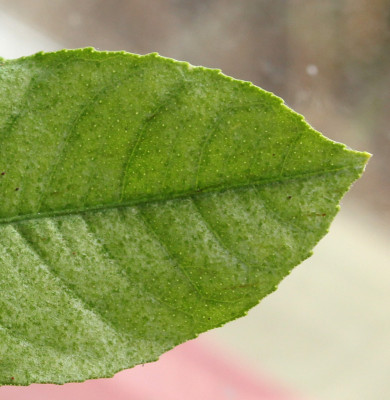
No panic; the plan was to wait a few weeks and see if the stippling disappears or if new growth, unstippled, develops. Citrus sometimes develop iron deficiency, which also yellows leaves, in cold soils, not because the soil lacks sufficient iron but because the roots aren’t at the top of their game in cold soil.
A closer look a few days ago revealed, to the naked eye, very small black specks on the leaves. An even closer look, with a hand-held lens, revealed tiny mites crawling around on the leaves.
Mites are mostly problems in dry, dusty conditions, not atypical for a house heated in winter and the usual for summer in Mediterranean climates such as California. One simple cure is to make conditions less dry and dusty. Climate change within the whole house would be impractical. Instead, I started giving the plants a daily spritzing with water.
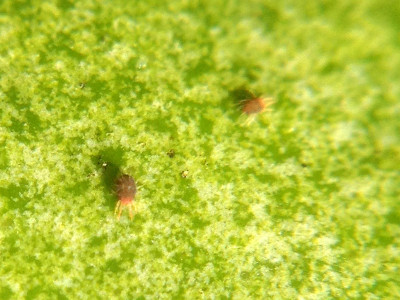
Mites, photo with iPhone + hand lens!
More potent sprays may be needed; fortunately they need not be toxic to humans. “Horticultural oil” sprays are effective as are sprays of insecticidal soap. Problem is that these sprays are inconvenient to use indoors, where excess spray would end up on windows, furniture, and floors. Sprays need to be repeated weekly to kill mites that hatched from eggs (which are spray resistant) since the last spray.
Because the Meyer lemon cuttings are still small with very few leaves, I chose to go at them mano a mano, merely rubbing my fingers across each leaf to crush the buggers (technically arachnoids, like spiders, not bugs). As with the oil or soap sprays, mano a mano combat must be repeated to crush newly hatched mites. But it’s quick and satisfying.
Mites do have many natural predators, among them other kinds of mites. Just like Jonathon Swift’s flea that “Hath smaller fleas that on him prey; And these have smaller still to bite ‘em; And so proceed ad infinitum.”
Low-Tech Auto Water
Every couple of days I have to think of all the plants in the house (they’re not all “houseplants”) that need water, including the mite-infested Meyer lemon cuttings. Two devices or setups keep me sane and my plants healthy in the face of all this watering.

Hydrospike
Larger, potted plants — those in pots over about 4 inches in diameter — are serviced by “water siphons” (aka “hydrospikes”, “self-watering probes”). A porous ceramic probe, previously soaked in water, filled with water, then capped, is pushed into the potting soil. The far end of the long, thin, flexible tube that comes out of the cap is plunked into a reservoir of water. I use mason jars as reservoirs and pre-fill the tube with water so that the water column is continuous from the ceramic probe to the reservoir.
Voila! As the potting soil dries out, it sucks water from the ceramic probe which sucks water along the tube from the reservoir. Larger pots need more than one ceramic probe.
 For smaller pots, I use capillary mats, which are nothing more than water-absorbing mats (available from www.gardeners.com) on which sit the pots. The mat is laid on a stand that sits above a similarly shaped, one-inch-deep tray, with one end of the mat dipping down into the tray. The mat absorbs water from the reservoir and the potting soil in the pots, as they dry, absorb water from the mat.
For smaller pots, I use capillary mats, which are nothing more than water-absorbing mats (available from www.gardeners.com) on which sit the pots. The mat is laid on a stand that sits above a similarly shaped, one-inch-deep tray, with one end of the mat dipping down into the tray. The mat absorbs water from the reservoir and the potting soil in the pots, as they dry, absorb water from the mat.
It’s important to maintain good capillary contact between the potting soil and the mat. This means no coarse drainage material in the bottom of the pots (a silly, counterproductive idea anyway), and no “feet” elevating the bottom of the pot.
Not having to frequently water makes it all too easy to forget about watering. I already lost one old rosemary plant this winter. Hydrospikes and capillary mats don’t work — duh! — unless their reservoirs have water in them.
OLIVE HARVEST IN FULL SWING HERE
/9 Comments/in Fruit, Gardening, Houseplants, Soil/by Lee ReichWhat To Do With This Year’s Harvest?
Olive harvest will begin — and end — here this week. Yes, it’s late. After all, the harvest in Italy was in full swing weeks ago, back in autumn. But this is the Hudson Valley, in New York. What do you expect?
I’m talking about harvesting real olives, not Russian olives (Elaeagnus angustifolia) or autumn olive (E. umbellata), both of which grow extensively in a lot of places, including here. Too extensively, according to some people, which is why they’re listed as “invasives” and banned from being planted in some regions. (But their fruits are very tasty, their flowers are very fragrant, their leaves are very ornamental, and their roots enrich the soil with nitrogen from the air, all of which garnered them a chapter in my book Uncommon Fruits for Every Garden.)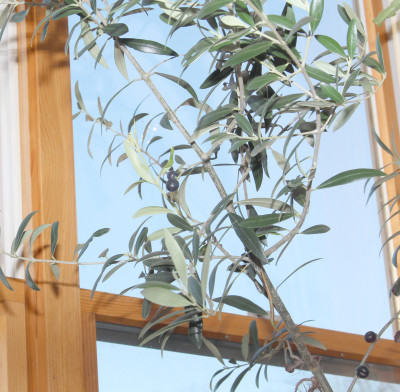
Present harvest here is of the true olive (Olea europaea), unrelated to the previously mentioned olives. Temperatures in the Hudson Valley, and beyond, would spell death to an olive tree, which is cold-hardy to about 14°F, so my tree is planted in a pot, just like my other Mediterranean-climate plants — fig, pomegranate, feijoa, black mulberry, bay laurel, kumquat, black mulberry, and Golden Nugget mandarin (tangerine). I can handle only so many potted, small trees, so it’s lucky that my olive doesn’t need a mate to bear fruit; it’s the self-fruitful variety Arbequina. The plant I got a few years ago from Raintree Nursery started bearing its first season!
Unlike my fig, pomegranate, and mulberry, olive is evergreen, so it needs light year ‘round. Fig, and company, are in a dark corner of my cold basement, dormant. The olive is in a cool room basking in sunlight from a south-facing window.
Two years ago, after an auspicious start, only one olive remained on the tree in late summer. I think my duck ate it.
This past fall, the harvest has increased many-fold — to almost a dozen fruits. What with being knocked around when moved indoors and the change in environment, about half that number of fruits now hang from the branches.
I like my olives fully ripe, black, so have let them hang as long as possible. Some are beginning to dry and shrivel, so it’s time to harvest. Fresh, the fruits are unpalatable, with a bitterness that comes from oleuropein. That bitterness is removed by curing and fermentation using lye, salt, and time. I’ve had naturally cured olives that use only the last ingredient, time, and that’s how I’m going to try mine.
For More Than Just Olive Fruits
A few years ago, I almost got rid of my olive tree. After all, it wasn’t making a dent in my olive consumption. Then someone pointed out that the olive, for thousands of years, has been a symbol of peace. That alone should be enough reason to keep the tree, and it was.
Also, the tree is pretty and long-lived — thousands of years, as documented by radiocarbon dating.
Secret Soil Recipe, Divulged (Again)
In preparation for the upcoming gardening season, I brought pails of frozen potting soil, compost, and soil in from the garage/barn. Soon I’ll need to trim back roots and repot some of those Mediterranean-climate fruits, including my Arbequina olive. Not my Meiwa kumquat, though, some of whose green fruits are showing hints of yellow, foreshadowing ripening to begin over the next couple of months. Trimming back its roots would cause branches to let go of fruits.
Potting soil will also be needed for the first seeds of the season, to be sown indoors in the next week or so.
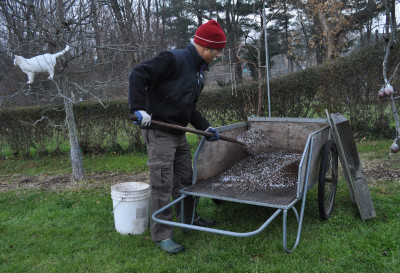 I will now divulge my recipe for potting soil. The main ingredients are garden soil, compost, peat moss, and perlite. I thoroughly mix together equal volumes of these four ingredients, then add a cup of soybean or alfalfa meal (for extra nitrogen). If I’m feeling generous, I also throw in a half a cup or so of kelp meal (for micronutrients, although it’s probably superfluous with the panoply of nutrients from the compost). Perhaps also a half a cup of dolomitic limestone (for alkalinity, calcium, and magnesium, also probably superfluous with the buffering action and richness of the compost). Using wooden frames onto which I’ve stapled 1/2 inch hardware cloth, I sift together the mixture.
I will now divulge my recipe for potting soil. The main ingredients are garden soil, compost, peat moss, and perlite. I thoroughly mix together equal volumes of these four ingredients, then add a cup of soybean or alfalfa meal (for extra nitrogen). If I’m feeling generous, I also throw in a half a cup or so of kelp meal (for micronutrients, although it’s probably superfluous with the panoply of nutrients from the compost). Perhaps also a half a cup of dolomitic limestone (for alkalinity, calcium, and magnesium, also probably superfluous with the buffering action and richness of the compost). Using wooden frames onto which I’ve stapled 1/2 inch hardware cloth, I sift together the mixture.
Ten gallons of potting soil should carry me through winter until the compost piles and the soil have defrosted.
Olive Curing Update
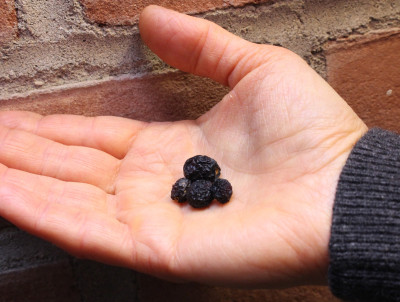
Olives harvested and cured.
It’s now some days after I first wrote the above. Olives received no other treatment except being left to dry and wrinkle. Tasted them today — delicious! (I’m going to plan for bigger harvests for the future.)
CHERRIES JUBILEE (I HOPE)
/8 Comments/in Fruit, Gardening, Planning/by Lee ReichMore Plants?!?!?!
You’d think, after decades of gardening in the same place, that I by now would have planted every tree, shrub, and vine I could ever want or have space for. Not so! Every year I make up a “Plants to order” list, unfortunately before I hone down just where I’ll sink my shovel into the ground to prepare a planting hole.
Topping my list was Carmine Jewel cherry, a tart cherry that’s also good fresh. (Tart cherries often have higher sugar levels than do sweet cherries; but they also have tartness and other flavors that offset that sweetness.) The biggest draw for Carmine Jewel is its stature — no more, at maturity than 6 or 7 feet high. And a bush, not a grafted tree, so that if cold or deer nip back branches, new sprouts from ground level bear the same cherries that the rest of the bush does or did.
As a bush, Carmine Jewel is easy to net against birds, and easy to harvest. One big unknown is pest resistance and its flavor — that is, whether or not I will like it.
Some research indicated that Carmine Jewell is a hybrid of Prunus cerasus, which is the genus for conventional tart cherries, and P. fruticosa, a hardly edible cherry that offers bushiness to its offspring. It’s often listed, botanically, as P. X kerrasis, after Dr. Kerr who started this breeding line way back in the 1940s.
Carmine No, Juliet Yes
One benefit — to me — of this weekly column is that it forces me to research more deeply topics or plants that I might otherwise gloss over. Said research this week makes me cross Carmine Jewel off my “Plants to order” list.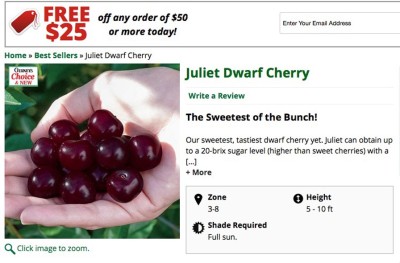
Carmine Jewel, it turns out, has siblings. Among its siblings, it’s one of most tart. A newer group of siblings, the Romance series, were born in 2004, whose fruits are larger and sweeter. From this group, the variety Juliet was very productive and the sweetest. (Romeo was also quite good, but not as sweet.) So Juliet it is for me.
It remains to be seen just how good Juliet tastes, and how resistant it is to common cherry pests.
Nanking Cherries, All Good
Between the first paragraph and now I’ve figured out where to make Juliet home — in the “available seat” in the row of Nanking cherries (Prunus tomentosa) that line my driveway. This position will also make easy comparisons with the Nankings, one of the most reliable, tasty, care-free, and ornamental cherries I grow.
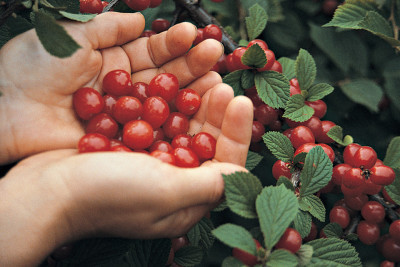
Nanking cherries, easy, good, quick to bear, prolific
Nanking cherries, despite snowballs of pinkish white blossoms every year, sometimes followed by frosts, have never failed to offer more cherries than we could possibly eat. I prune the bushes only to keep them from swelling to their 10 foot high and wide full size. The only downside to the fruits is that they are small. But they’re so good they earned themselves a whole chapter in my book Uncommon Fruits for Every Garden.
Choke(!)berry, Maybe
I recently learned that I may qualify to wear a longsleeve, blue T-shirt emblazoned with a large S. The S won’t stand for Superman, but for Supertaster. I sifted out this information with another fruit bush that was on my “plants to order” list: chokeberry (Aronia melanocarpa).
About twenty years ago I planted a chokeberry bush. It fruited rather quickly, I tasted the fruit, spat it out, and dug up the plant.
A few weeks ago I was talking with a young farmer and after agreeing on the delectable flavor of black currants, he mentioned that chokeberry was another of his favorite fruits. “They’re awful,” said I. “Not if they’re cooked, frozen, or dried,” said he. Hmmm . . . chokeberry’s bite is from astringency, which, does dissipate when certain fruits — persimmons, for example — are cooked, frozen, or dried. Perhaps chokeberry needs a second chance here.
Then I started reading about supertasters, whose palates can be very sensitive to certain organoleptic sensations — astringency, for instance. I must be a supertaster because the slightest amount of astringency induces my spit reflex (which is why I grow Mohler and Szukis persimmon, both of which yield ripe fruits with hardly a hint of astringency). Reading more about chokeberry, it seems that those who like the fruit don’t mind, but actually enjoy, some astringency. So chokeberry is now on my “Plants to order, maybe” list.
Taste aside, chokeberry has much to recommend it. It’s a beautiful landscape bush, white blossoms in spring and, on many varieties, fiery red leaves in fall. It tolerates cold to below minus 30° F., and some shade. It’s also cosmopolitan about the soil in which it’s planted.
Chokeberry garners a lot of attention these days because its among the highest of any temperate zone fruit in both antioxidants and anthocyanins. The anthocyanins are one contributor to the astringency.

